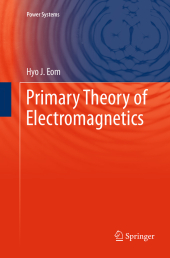 Neuerscheinungen 2016Stand: 2020-02-01 |
Schnellsuche
ISBN/Stichwort/Autor
|
Herderstra▀e 10
10625 Berlin
Tel.: 030 315 714 16
Fax 030 315 714 14
info@buchspektrum.de |

Hyo J. Eom
Primary Theory of Electromagnetics
Softcover reprint of the original 1st ed. 2013. 2016. ix, 205 S. 148 SW-Abb. 235 mm
Verlag/Jahr: SPRINGER NETHERLANDS; SPRINGER 2016
ISBN: 940240032X (940240032X)
Neue ISBN: 978-9402400328 (9789402400328)
Preis und Lieferzeit: Bitte klicken
This is a textbook on electromagnetics for undergraduate students in electrical engineering, information, and communications. The book contents are very compact and brief compared to other commonly known electromagnetic books for undergraduate students and emphasizes mathematical aspects of basic electromagnetic theory. The book presents basic electromagnetic theory starting from static fields to time-varying fields. Topics are divided into static electric fields, static magnetic fields, time-varying fields, and electromagnetic waves. The goal of this textbook is to lead students away from memorization, but towards a deeper understanding of formulas that are used in electromagnetic theory. Many formulas commonly used for electromagnetic analysis are mathematically derived from a few empirical laws. Physical interpretations of formulas are de-emphasized. Each important formula is framed to indicate its significance. Primary Theory of Electromagnetics shows a clear and rigorous account of formulas in a consistent manner, thus letting students understand how electromagnetic formulas are related to each other.
1 Vectors. 1.1 Vector Operations. 1.2 Orthogonal Coordinates. 1.3 Operator Del, Divergence Theorem, and Stokes┤s Theorem. 1.4 Problems for Chapter 1.
2 Electrostatics. 2.1 Fundamentals of Electric Fields. 2.2 Dielectrics and Boundary Conditions. 2.3 Capacitance. 2.4 Electrostatic Energy. 2.5 Poisson┤s Equation for Electric Fields. 2.6 Image Method. 2.7 Problems for Chapter 2.
3 Magnetostatics. 3.1 Conduction Currents. 3.2 Fundamentals of Magnetic Fields. 3.3 Magnetic Forces and Torques. 3.4 Magnetic Materials and Boundary Conditions. 3.5 Poisson┤s Equation for Magnetic Fields. 3.6 Problems for Chapter 3.
4 Faraday┤s Law of Induction. 4.1 Faraday┤s Law. 4.2 Inductance. 4.3 Magnetic Energy. 4.4 Problems for Chapter 4.
5 Maxwell┤s Equations. 5.1 Continuity Equation and AmpŔre┤s Law. 5.2 Maxwell┤s Equations. 5.3 Poynting┤s Theorem. 5.4 Phasors for Time-Harmonic Fields. 5.5 Scalar and Vector Potentials. 5.6 Problems for Chapter 5.
6 Uniform Plane Waves. 6.1 Waves in Lossless Media. 6.2 Waves in Conductive Media. 6.3 Polarization of Plane Waves. 6.4 Reflection and Transmission. 6.5 Problems for Chapter 6.
7 Transmission Lines. 7.1 Fundamentals of Transmission Lines: Field Approach. 7.2 Fundamentals of Transmission Lines: Circuit Approach. 7.3 Terminated Transmission Lines. 7.4 Smith Chart. 7.5 Transient Waves on Transmission Lines. 7.6 Problems for Chapter 7.
8 Waveguides and Antennas. 8.1 Fundamentals of Waveguides. 8.2 Rectangular Waveguides. 8.3 Fundamentals of Antennas. 8.4 Wire Antennas. 8.5 Problems for Chapter 8.
A Symbols, Notations, and Acronyms. A.1 Symbols. A.2 Notations and Units. A.3 Acronyms.
B Vector Formulas. B.1 Additions and Products. B.2 Differential Operators.
C Gradients, Divergences, Curls, and Laplacians. C.1 Rectangular Coordinates (x; y; z). C.2 Cylindrical Coordinates (; ; z). C.3 Spherical Coordinates (r; ; ).
D Dirac Delta Functions.
E Answers to Problems.
Index.
Hyo J. Eom received the B.S. degree in electronic engineering from Seoul National University, Seoul, Korea, in 1973, and the M.S. and Ph.D. degrees in electrical engineering from the University of Kansas, Lawrence, USA, in 1977 and 1982, respectively. From 1981 to 1984, he was a Research Associate at the Remote Sensing Laboratory, University of Kansas. From 1984 to 1989, he was with the Faculty of the Department of Electrical Engineering and Computer Science, University of Illinois, Chicago, USA. In 1989, he joined the Department of Electrical Engineering, KAIST, Daejeon, Korea, where he is now a Professor. His research interests are electromagnetic wave theory and scattering.


